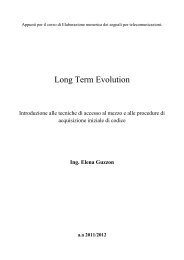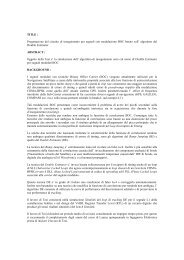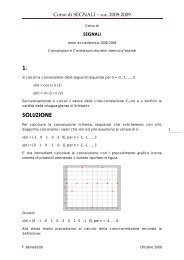G. Giunta, Lucidi del corso Elaborazione dei Segnali per ... - Comlab
G. Giunta, Lucidi del corso Elaborazione dei Segnali per ... - Comlab
G. Giunta, Lucidi del corso Elaborazione dei Segnali per ... - Comlab
You also want an ePaper? Increase the reach of your titles
YUMPU automatically turns print PDFs into web optimized ePapers that Google loves.
G. <strong>Giunta</strong>: <strong>Elaborazione</strong> <strong>dei</strong> <strong>Segnali</strong> <strong>per</strong> Telecomunicazioni (laurea specialistica) -lucidon.59<br />
• predizione lineare ottima<br />
Determiniamo i coefficienti {a i} con il criterio <strong>del</strong> minimo errore<br />
quadratico medio (MSE), essendo MSE = E[|e(n)| 2]<br />
condizione di minimo (<strong>per</strong> 1≤i≤N):<br />
∂ MSE ∂ E<br />
0 = = ∗<br />
∂ a ∂ a<br />
= E<br />
i<br />
[ ] 2<br />
e(<br />
n)<br />
∗<br />
= E[<br />
x ( n − i)<br />
e(<br />
n)<br />
]=<br />
∗<br />
i<br />
N<br />
∗<br />
∗<br />
{ x ( n − i)<br />
x(<br />
n)<br />
} + a E{<br />
x ( n − i)<br />
x(<br />
n − k)<br />
}<br />
k = 1<br />
∑<br />
<strong>per</strong> cui si ottengono le medesime equazioni di Yule-Walker:<br />
R<br />
xx<br />
( i)<br />
k<br />
N<br />
1<br />
a<br />
k<br />
R<br />
xx<br />
( i −<br />
k<br />
k)<br />
= 0<br />
( <strong>per</strong><br />
1≤<br />
i≤<br />
N)<br />
+∑ =<br />
Sotto tale condizione di minimo l'MSE assume il valore:<br />
σ<br />
2<br />
= min<br />
= E<br />
{ [ ] } 2<br />
E e(<br />
n)<br />
= E [ x(<br />
n)<br />
− xˆ ( n)<br />
]<br />
∑ ∗ { x(<br />
n)<br />
e(<br />
n)<br />
} = R xx ( 0)<br />
+<br />
N<br />
k=<br />
1<br />
{ e(<br />
n)<br />
} ∗<br />
a<br />
k<br />
R<br />
xx<br />
( −k)<br />
Osservazione: il filtro (di ordine N) <strong>del</strong>l'errore di predizione<br />
su {x(n)} e' l'inverso <strong>del</strong> mo<strong>del</strong>lo AR (di ordine N) di {x(n)}. E'<br />
sempre a fase minima, dato che il suo inverso e' causale.<br />
Osservazione: i coefficienti <strong>del</strong> predittore lineare ottimo <strong>del</strong>la<br />
serie {x(n)} di ordine N-1 sono IDENTICI a quelli <strong>del</strong> mo<strong>del</strong>lo<br />
AR di ordine N <strong>del</strong>la stessa serie {x(n)}.










